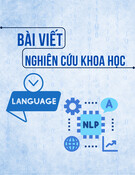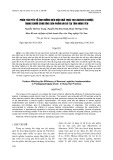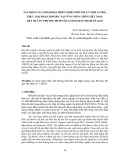
* Corresponding author
E-mail address: alhazmi1976@gmail.com (N. M. Al-Hazmi)
© 2020 by the authors; licensee Growing Science.
doi: 10.5267/j.uscm.2020.4.002
Uncertain Supply Chain Management 8 (2020) 505–512
Contents lists available at GrowingScience
Uncertain Supply Chain Management
home
p
a
g
e: www.Growin
g
Science.com/usc
m
The impact of information technology on the design of distribution channels
Nabil Mohemmed Al-Hazmia,b*
aAssociate Professor of Marketing-Department of Marketing, College of Business Administration, Prince Sattam bin Abdulaziz University-Kingdom of
Saudi Arabia
bAssociate Professor of Marketing-College of Administrative Sciences- Taiz University-Yemen
C H R O N I C L E A B S T R A C T
Article history:
Received January 29, 2020
Received in revised format March
2, 2020
Accepted March 11 2020
Available online
March 14 2020
The study aims to identify the impact of information technology on the distribution of services
of tourist institutions in the city of Al-Kharj in the Kingdom of Saudi Arabia. The survey was
concentrated on a number of institutions represented in hotels, restaurants and travel and
tourism agencies. The results indicate that the information technology had no meaningful effect
on the distribution of tourism services in Al-Kharj. A set of recommendations was also
presented to tourism organizations represented in the image of using social media to distribute
tourism services as well as using and activating the websites of tourist institutions themselves
when making reservations for their services and the necessity of activating and using electronic
payment methods.
.2020 b
y
the authors; license Growin
g
Science, Canada©
Keywords:
Distribution channels
Information technology
Tourism services
Tourism organizations
1. Introduction
The world has witnessed today a wave of rapid changes and developments, which have added its
impacts on all levels of the economy, whether partial or overall, and at various levels. Specialists have
agreed to call it globalization. We find that the most important component of making this privacy and
excellence in it is information technology. Although, this term is made up of two broad concepts;
namely information and communication. Despite their vastness and depth, they are closely related and
interconnected. Without the information and its technologies, there would be no communication, and
no means of communication would have been developed, and without communication and its
technologies, the information would not have attained the importance that it is now. In addition, their
interconnection has the greatest impact on the phenomenon that the world lives today, and one of its
most important features is the elimination of spatial and temporal barriers, thanks to the internet, the
fruit of information technology, which enabled the whole world to communicate and exchange
information everywhere and at any time with the whole world. It also had great favor for changing the
style and management of institutions. In order for the organization to be able to attract the largest
possible number of customers and increase its effectiveness in the market in which it operates, it must
search for the best ways and methods that enable it to improve its goods and services, simplify

506
workflow procedures and upgrade the levels of worker performance. Then the institution can raise
efficiency, which is reflected on the quality of goods and services with the needs and desires derived
from the institutions. This is also reflected to what is known as the adoption of modern marketing
thinking. Many organizations, including tourism organizations, started to get benefit from electronic
marketing and were able to achieve unprecedented results in terms of increasing the market share,
through the provision of advanced tourism services that achieve customers' satisfaction and provide
them with the spatial and temporal benefit at the same time, by relying on advanced distribution
channels that are distinguished by their superior ability to transmit data, such as cell phones and the
internet, which enabled tourism organizations to develop their method of offering their services. In
addition to that, they were able to reduce the costs of producing, displaying and distributing tourism
with goods and services which led to a low selling price. The growing popularity of information
technology and the developments and improvements which happen on the internet day after day, have
made everyone's attention focus on the threat to disappear from the marketing mix, which is
distribution. The role of intermediaries began to decline and disappear in facilitating the flow of goods
and services from the product to the customer, based on the emergence of electronic markets, as an
expected result of information and communications technology. Saudi tourism organizations, like other
tourism organizations at the international level, have been concerned with information technology and
included it in the processes of promotion and distribution of their services provided within the Saudi
tourism market. This is on a way that guarantees the process of disseminating the needs and desires of
its customers with accuracy. This is through achieving the customer satisfaction and gaining loyalty to
the goods and services provided by these institutions to them through electronic means, and in a manner
that guarantees high quality of the tourism product provided in Al-Kharj Governorate.
2. Study Problem
The idea of studying this issue is demonstrated through a basic problem experienced by tourism
organizations in the city of Al-Kharj in the Kingdom of Saudi Arabia due to the lack of interest in the
subject of traditional marketing. This is associated with marketing in light of information technology,
as the distribution of tourism services and the realization of spatial and temporal benefit to it is not
satisfactory, and this is due to the nature of the tourist service on the one hand, and to the marketing
mechanisms that follow in the tourism organizations in Al-Kharj city. On the other hand, we can
express the problem of studying through the following question:
What is the impact of information technology on designing the distribution channels of services of
tourist institutions in the city of Al-Kharj in the Kingdom of Saudi Arabia?
2.1 The hypothesis of the study
This study seeks to test the following hypothesis:
There is no correlation relationship and statistically significant impact at the level of significance
(α≤0.05) for information technology on the distribution of tourism services to tourism organizations in
Al-Kharj city.
2.2 Study objectives
The study aims to identify the impact of information technology on designing the distribution channels
of tourism services in tourism organizations in the Saudi Al-Kharj Governorate and clarify the role that
information technology plays in developing the distribution system for tourism services in a manner
which works to achieve the common benefit of tourism organizations on the one hand and their
customers on the other.
2.3 Study importance
The importance of this study comes from the role that information technology plays in developing the
tourism product and achieving its temporal and spatial benefit, which helps in developing the level of

N. M. Al-Hazmi /Uncertain Supply Chain Management 8 (2020) 507
tourism services offered by tourism organizations in Al-Kharj Governorate and thus working to satisfy
customers' arguments and desires better than competitors, whether in other provinces or overall, in the
Kingdom.
2.4 Study methodology
The study depended on the descriptive analytical approach through presenting various concepts related
to the subject of the impact of information technology on designing the distribution channels of tourism
services through access to many books and previous studies related to the subject and also used many
of the sites available within the internet and for tourism organizations in Al-Kharj city, and depended
on a case study method where a special questionnaire was designed to answer study questions related
to the impact of information technology on designing the distribution channels of tourism services in
Al-Kharj Governorate.
2.5 Study limitations
The study limitations are as follow:
Objective limits: The study examined the impact of information technology on designing the
distribution channels of tourism services.
Spatial limits: This study was conducted on tourism organizations in Al-Kharj city in the Kingdom of
Saudi Arabia.
Temporal limits: This study was conducted from September 2019 to March 2020.
2.6 Study population & sample
The study population was represented by the tourism organizations operating in the city of Al-Kharj
consisting of hotels, travel and tourism agencies, transport companies and restaurants. The study sample
was randomly chosen from the study population where 60 tourism organizations were chosen and the
questionnaire was distributed to them, and all distributed questionnaires were restored.
Table 1
Distribution of the study sample to tourism organizations in Al-Kharj Governorate *
100% Percentage Number of organizations selected Type of tourist organization No.
16.666 10 Hotels 1
16.666 10 Travel and tourism agencies 2
33.333 20 Restaurants 3
16.666 10 Transport companies 4
16.666 10 Cafes 5
100% 60 Total
*Prepared by the researcher.
2.7 Study Tool validity & stability
As it was confirmed, the validity & stability of the study tool as follow:
A- The study tool validity: A questionnaire was presented to a number of arbitrators from the
faculty members at (Prince Sattam University, King Abdulaziz University and Taiz University)
to verify the validity of its paragraphs, where some suggestions were made and were taken when
preparing the questionnaire in its final form.
B- The stability of the study tool: to find out the stability of the study tool, an internal stability
equation method was used using the Alpha Cronbach test, where the values of the Cronbach
Alpha for the questionnaire were 87,000 and this value is sufficient for the indications of
scientific research.

508
2.8 Study model
Fig. 1. Study model
3. Literature Review
There are quite a few studies associated with the impact of information technology on designing tourism
services distribution channels in general, but there is not a single study that addresses this issue at the
level of Al-Kharj Governorate (Emadaldain, 2016) The study dealt with the role of information
technology in choosing a marketing strategy and has concluded that there was a strong relationship
between the type of technology used and the marketing strategy followed, and that there was a strategic
role played by the followed marketing strategy by identifying the type of technology required in
institutions and also stressed that information was an important strategic resource in the organization
through its characteristics that lead to influence various activities of the institution. Al-kadifi (2014)
investigated the impact of information technology on the marketing mix of service institutions, and
found that there was a relationship between information technology and each of the different elements
of the marketing mix. They believed the need to pay attention to the technological structure of service
institutions and the need to work to introduce modern technological means, whether in terms of
production or the management of these institutions. The study Al-taip (2014) dealt with the distribution
policies in service institutions. It concluded that there was a relationship between the type of
distribution policy used in the institution and the type of technological development that is involved in
it and recommended the need to adopt modern methods and techniques used in distributing goods and
services and using social media. Aklli (2019) examined the role of distribution policies in achieving
competitive advantage in service institutions. There has been a role for distribution policies pursued by
the institution in achieving competitive advantage when compared to other competitors in the same
market, and recommended the need for excellence when preparing and designing distribution channels
for the institutions' products, with the necessity of adopting modern styles of distribution channels that
use modern technological means. Rabih (2018) investigated the impact of the internet on the
distribution of insurance institutions services. The study concluded that there is an impact of the
network on the delivery of parameters for insurance institutions as well as the impact on the distribution
of services without the use of intermediaries and recommended that work should be done to increase
the use of the network, the internet and replace it with the insurance brokers. Somaih (2018) examined
the role of distribution policies in improving the competitiveness of institutions, and concluded that
distribution contributes to improve the competitiveness of the institutions under study. The author
recommended the need to pay attention to the type of distribution policy used by the institution and
work to introduce modern means of distribution that depend on information technology. The study by
Othmani (2018) aimed to determine the impact of the distribution policy on the market share of business
Information
Technology
(IT)
Distribution
of Services
Tourism
Organizations

N. M. Al-Hazmi /Uncertain Supply Chain Management 8 (2020) 509
institutions, and the most important conclusion was the existence of an association relationship and
impact between the distribution policy and market share, and presented a set of recommendations that
focus on the role of a good distribution policy in increasing the market share of the enterprise. The
study by Obaid (2018) dealt with the relationship between customers' satisfaction and the type of
marketing strategy followed by the institutions. The study reached the customer that uses several
dimensions to assess the level of quality of service that he actually gets, as the options varied in the use
of marketing strategies, and each strategy of these strategies has specific features that can be applied to
address a specific situation to achieve customers' satisfaction. AL-Hazmi and Alkhateeb (2020) dealt
with the barriers of tourism marketing that affect the level of perceptions of the tourist about the tourism
services provided by the tourism organizations in Al-Kharj Governorate, and recommended the need
to pay attention to technological communication means and prepare a promotional message capable of
raising the level of awareness among tourists about tourism services in Al-Kharj Governorate. While
AL-Hazmi and Hassan (2020) tackled the barriers of applying Total Quality Management to the tourism
product in Al-Kharj Governorate, and recommended the need to use technology to achieve and raise
the quality of marketing tourism services in Al-Kharj Governorate. Al-Hazmia (2020) examined the
dimensions of the quality of tourism services in Al-Kharj Governorate, and recommended the necessity
of training workers in the field of providing tourism services in Al-Kharj and working to develop means
of providing tourism services.
Through reviewing the previous studies, we find that most of them dealt with the impact of technology
on the distribution of services or products that differ from tourism services and in regions that differ
from Al-Kharj Governorate. From here, this study has the advantage of dealing with the impact of
information technology on designing the distribution channels of tourism services to tourism
organizations in Al-Kharj Governorate in the Kingdom of Saudi Arabia.
4. Analytical side
4.1 Data analysis of the impact of information technology on designing the distribution channels of
tourism services of tourist institutions in Al-Kharj Governorate
To answer the study question related to the impact of information technology on designing the
distribution channels of services of tourist institutions in Al-Kharj Governorate, an arithmetic mean
and standard deviation were used, and Table 2 illustrates this. From the table, we find that Paragraph
No. (11) which states “The organization uses advertising links in electronic tourist sites in order
to distribute its services” came first with an average of 3.101 and a standard deviation of 1.091.
This indicates that tourism organizations in Al-Kharj Governorate announce their services in
electronic tourist sites in order to deliver their services to the beneficiaries wherever they are.
While paragraph (8) which states, “The organization uses social networks to distribute its
services (Facebook-Twitter-Whatsapp-tic-talk)” comes in second place with an average of
3.829 and a standard deviation of 1.521, which indicates that tourism organizations in Al-Kharj
Governorate use various social communication methods to deliver their services to their
customers and facilitate the reservation process for them. While paragraph (13) which states,
“Electronic means are used in the process of paying for the services of the organization” with
an average of 2.818 and a standard deviation of 1.098 indicates that tourism organizations in
the Al-Kharj Governorate use electronic payment methods in a medium way and approaching
a few. While paragraph (15) which states “The phone is used in reservations for the services
of tourist institution” in the last rank with an average of 2.818 and a standard deviation of 1.071
indicates that tourism organizations in Al-Kharj Governorate do not always use the phone in
the reservation and distribution process for their services with their customers and beneficiaries
of their services. From Table 2 we also find that the average answers to the total paragraphs were
3.434 and a total standard deviation of 3.434 and this approximates to the mean in the sense that the
use of electronic means in distributing tourism services to tourist institutions in Al-Kharj Governorate






![Logistics xanh: Phát triển bền vững ở Việt Nam [Mới Nhất]](https://cdn.tailieu.vn/images/document/thumbnail/2024/20240202/vigojek/135x160/4221706863853.jpg)



















